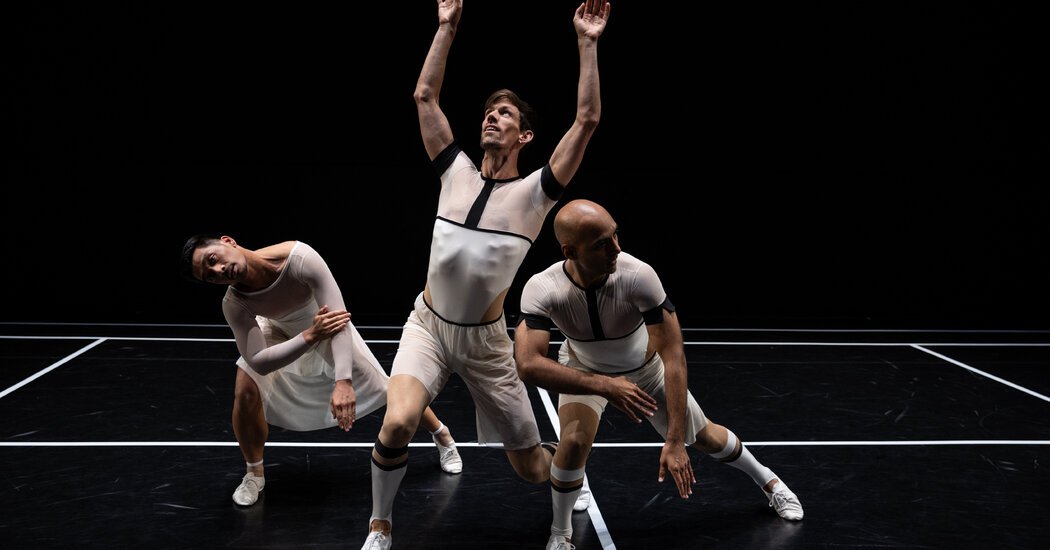[ad_1]
The threesome was Diaghilev’s idea. For the 1913 ballet “Jeux,” Diaghilev, the impresario of the Ballets Russes, wanted a homosexual encounter among three men to be depicted. Debussy, the composer of the work, objected. So the choreographer, Vaslav Nijinsky, straightened the scenario into two women and one man flirting on a tennis court.
The new “Jeux” that Christopher Williams debuted at the Baryshnikov Arts Center on Thursday restores Diaghilev’s idea. Three men cavort, one of them in a tennis skirt. This and the other premiere on the program — “A Child’s Tale,” Williams’s version of “Contes Russes,” a 1917 ballet by Leonid Massine — are the latest in a series in which Williams takes works by the Ballets Russes, the early 20th-century company that brought Russian ballet to Europe and into modernism, and thoroughly reimagines them: queering, or in some cases, re-queering them.
But Williams’s “Jeux” does more than rescue the suppressed gay scenario. It doubles the dance. At the end of the original the encounter is disrupted by a tossed tennis ball, but here the ball is followed by a thunderstorm (many balls) and the sound of a plane crash (a discarded Nijinsky idea). The music starts over, and a new trio of dancers repeats the choreography, three women this time, one in male attire. The first trio joins in as ghosts.
It’s a bold move, and a saving one. The first go-round is gently campy, with languorous poses and woozy encircling to Debussy’s sliding strings. The love triangle keeps splitting into two and one, until the person left out objects. There’s horsing around, a slap, a fall, some orgasmic shuddering. Williams borrows a few of the pretzeled poses from photos of the lost original and cat’s cradle bits from Millicent Hodson’s 1990s reconstruction.
Much of this is beautiful, and beautifully danced. The loose fists that the critic Edwin Denby called mysterious retain their mystery. But it’s also a trifle wan. The doubling fixes the problem, especially since the two trios braid ingeniously, and the extra bodies help match the scale of the score. The ghosts add poetic resonance to the act of reconstruction.
For “A Child’s Tale,” Williams has retained the score by Anatoly Lyadov and some figures from Slavic folklore: the house spirit called Kikimora and the sorceress Baba Yaga, whose house walks about on chicken legs. But he has devised his own story, an invented folk tale about a bride who miscarries and discovers a foundling child, a story of death, revenge, supernatural forces and sacrifice.
The result is remarkably like a lost storybook ballet from more than a hundred years ago, with both the old-fashioned charm and the old-fashioned dull spots. You have to read the written synopsis to follow the plot in detail, but the gist comes across vividly enough, particularly through Ukrainian-inspired costumes by the dream team of Reid Bartelme, Harriet Jung and Andrew Jordan.
Baba Yaga is split into three witches with false noses, wonderfully characterized with a treelike physicality. The foundling (a superb Mac Twining) is feral, bounding about on all fours and scratching himself like the Wild Boy of Aveyron. The villagers hunt him with spears. The Kikimora (Caitlin Scranton), wearing a pitchfork and branches in her hair, is affecting as a misunderstood outsider, powerful but well meaning, like a spirit in a Miyazaki film.
This is a mode that brings out Williams’s distinctive gifts and sensibility, antiquarian and odd. He picks up and revives a period quality from the archival remains of choreography by Nijinsky and Massine and also by Nijinsky’s sister, Nijinska. You can see it in the tilted heads. In “Jeux,” the tilt is sculptural, modern. In “A Child’s Tale,” it’s sad, weighted with the truth of mortality.
Christopher Williams
Through Sunday at Baryshnikov Arts Center; bacnyc.org.
[ad_2]
